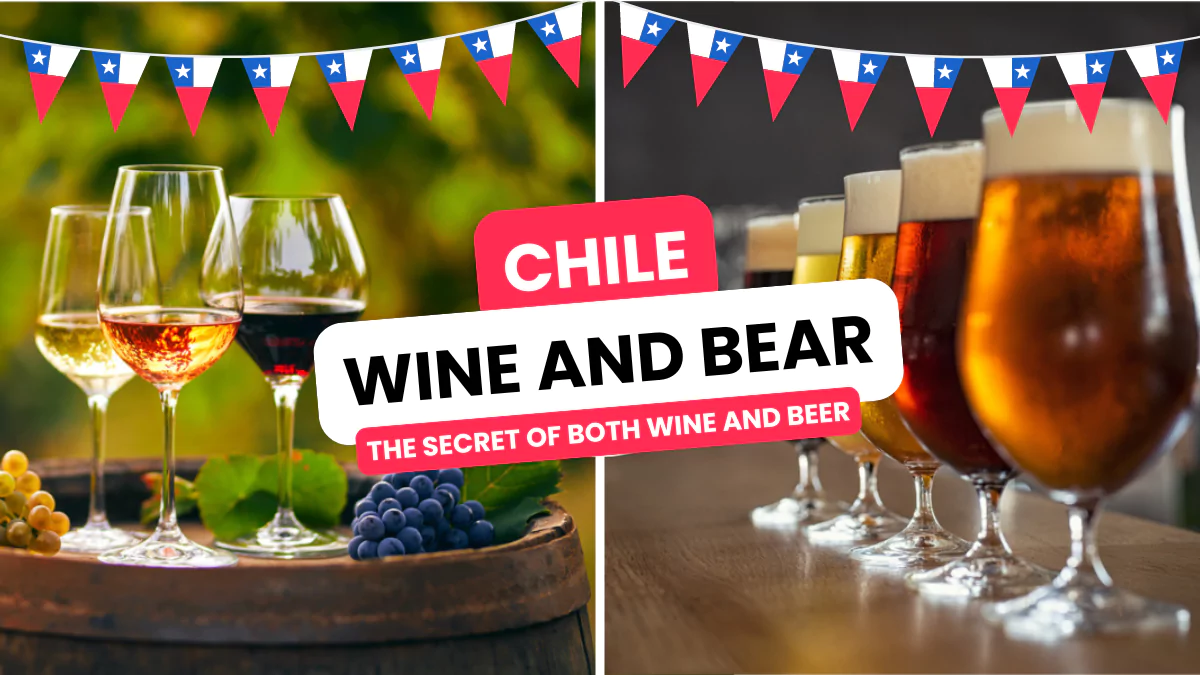Chile not only offers stunning landscapes from the Andes Mountains to the Pacific coast, but also has a rich wine culture that is known around the world. In addition, its ever-growing beer culture attracts gourmets and adventurers alike. Let’s get to know what makes Chile so special!

Table of Contents
Chile Wine: Enjoying the Earth in a glass
While wine has been produced in Chile for centuries, until the 1990s wine produced in Chile remained in Chile, which explains why the international knowledge of Chilean wines still seems very recent compared to the history of wine producing countries such as France and Italy. But once Chilean winemakers began exporting their wine and entering the global market, it didn’t take long for the world to recognize the quality and value of Chilean wine.
Chile’s climate lies somewhere between California and southern France, with a wide range of elevations and soils that range from silt and clay to sand and decomposed mammary rock. The diversity of elements allows the successful cultivation of all kinds of grapes, from Sauvignon Blanc to Pinot Noir and Cabernet Sauvignon.

Wine has been produced since the 16th century. At that time, the wineries mostly concentrated on the production of high-value, everyday drinking wines for the mass market.
However, there is an increasing number of pioneering producers who focus on fine wine production.
Verdict of the Berlin tasting
In 2004, Eduardo Cadwick, an enterprising Chilean wine producer, organized the „Berlin tasting”. In a bold move, he invited experts from all over the world to a blind tasting, where he put together wines such as Mounton Rothschild, Lafite Rothschild, Solaia, Sassacaia from his selected wines. and Latour. The wines were all from the 2000 and 2001 vintages, and many received perfect scores from wine expert Robert Parker. Videndo Chadwick 2000 was the overall winner, Sene 2001 was second, and Don Maximiano Founder1s Reserve also made the top ten.
Chilean wine regions: Enjoying the Earth in a glass
Although this long, thin country has many wine regions, here are 3 of the country’s most famous wine regions

Central Valley (Valle Central) region
from Viognier to Riesling to Cabernet Sauvignon, Merlot and Syrah in the cool, wet parts of the northern valley, and in the warm, dry parts of the southern valley, wine lovers can enjoy a variety of varietals and blends.
Central Chile’s Bodeagas y Vinedos De Aguirre winery is a wine lover’s dream offering tastings of the region’s iconic red varietals and blends alongside a selection of cold and refreshing whites.

Colchagua – valley
popular Chilean red wines such as Cabernet Sauvignon, Syrah. The valley, famous for the production of Merlot, is one of the country’s most profitable wine regions.

with a warm climate slightly influenced by cool ocean breezes, the region has fertile soil and an excellent reputation that makes it the crown jewel of the Chilean wine industry.
Plus, if you prefer white wines, the cooler, western part of the region makes excellent Chardonnay and Sauvignon Blanc, setting itself apart from the army of fine reds produced in the warmer, eastern region of the valley.
If you want an authentic experience in the valley, TerAustral Wines offers you the opportunity to admire the beauty of the Cihe region and taste a huge selection of wines.
Maule – valley
As Chile’s largest wine-producing region, the Muale Valley is a thriving center for world-renowned South American wines.
The region makes excellent use of its 75,000 hectares of rich soil to grow and produce wonderful reds such as Cabernet Savignon, Carmenére, Syrah.

While red wines thrive in this growing area thanks to its fertile, free-draining soil and generally warm climate, you can undoubtedly find fantastic white wines like Chardonnay from the cooler areas of this iconic region.
A special grape variety that is only grown in Chile
One of the most unique grape varieties in Chile is the so-called Carmenère, which was originally bred from France – it was once one of the most popular French wine grapes – but it was completely lost from the motherland during the phyllocera disease (grape disease).
However, it remained in Chile, and although it was long thought to be Merlot because of the obvious similarities, it soon became clear that it was a separate grape variety.
For carmén, a blue grape, which is typically long-aged, has an extremely unique aroma, and can be used to make a red wine with peppery effects.
Although we are basically talking about a Mediterranean climate, the lean soil, the dry summer and the rainy winter make all chili grape varieties quite unique, which usually boast a long ripening period.

In the Chilean economy, winemaking now plays one of the most important and significant roles, which is clearly shown by the fact that in the 4,500 km long country, if we were to place each vineyard next to each other, we would get a piece of land more than 900 km long and 150 km wide
Chile Beer: Craft flavors at the end of the world
Chile’s beer culture is also developing rapidly and local craft breweries are offering more and more special flavors and characters.
Want to see what’s happening in Chile’s craft beer scene?
The first and best-known craft beer that Chile offers comes from the south, mainly from the wine-growing town of Valdivia, often referred to as the beer capital of Chile. Many excellent varieties have a balsamic and chocolate flavor, with malt flavors with caramel, an excellent choice with a high alcohol concentration.
Located in central Chile, particularly in the town of Penaflor, 30 km from Santiago, there is a great selection of refreshing craft beers with lemony aromas and peppery aromas that stand out with their distinctive taste.
If you want something more exotic, try the craft beer from the coast, famous for its mix of mint, rue, grapefruit and mango. Although it has a slight bitterness, it balances very well with the mint, making it very refreshing for a summer afternoon, especially because of its light alcohol concentration.

The hoppier ones combine aromas and flavors, such as caramelized nuts, sweet bread and brandy, or cherries and cider. The ABV value (alcohol by volume) of these varieties is around 9%. Ranging in color from pale tiramisu to dark black forest cherry, these are desserts that go well with beer of the same color.
Types:
- Austral lager: this is the first creation of Cervecería Austal, the southernmost beer in the world
- Austral Calafate: it owes its name to a fruit that is unique in the world and can only be found in the geographical richness of Patagonia
- Patagonia 508: born in recognition of the street where 1896 hours of all kinds of Austral beers are brewed
- Austral Yagan: a tribute to the natives who inhabited the islands and canals at the end of the world. A beer that showcases the greatness of a city that will never be forgotten
- Torres del Painer: a tribute to the national park of Chile, which is the eighth chocolate in the world
- Ruibarbo: a beer that owes its name to a plant of Asian origin characterized by its thick reddish stems.
Discover how the world’s southernmost beer was born:
In 1896, German master brewer José Fischer arrived in Punta Arenas with the aim of setting up the country’s first brewery. With this dream in mind, José founded “Cerveceria La Patagonia”, now known as Cerveceria Austral.

Cervecería Austral managed to keep its production processes almost unchanged, thus paying homage to José Fischer. Its beers, made with ingredients and the purest Patagonian water, will blow us away thanks to their unique taste.
How beer is made
raw materials: these materials are incorporated into the 4 key processes of brewing
- barley: source of starch
- hops: responsible for the characteristic aroma and taste
- yeast: the key to the alcohol content
- water: the main element from Patagonia

It all starts with the preparation of the barley grains, which pass through a mill that carefully grinds the inside, leaving the husk intact. The starches in the grains are then converted into fermentable sugars with water and temperature. It then goes into a filter, where the lids allow the liquid to flow, and so the wort is sent to the kettle, where the sugars are concentrated, the wort is sterilized and the hops responsible for the beer’s characteristic bitterness are incorporated.

When the must cools down to 10C, it is ready for the fermentation process. This is where the yeast is added, which is responsible for converting the sugars into alcohol and producing CO2, which is the element that provides the bubbles that are so necessary for a good beer. This process takes 7-8 days, where they check its quality through samples, checking the fermentation process

Once fermentation is complete, the tank is cooled, the yeast is decanted and removed once the job is done. The liquid, known as green beer, is poured into resting tanks at a low temperature for 20-25 days, ensuring that the beer stabilizes

The filtration process is key to imparting the beer’s color, brightness, and clarity, as well as removing suspended solids. Once this process is complete, the beer is ready for pasteurization and packaging.
Chile’s wines and beers are not just drinks, but part of the whole culture, which shows the richness and diversity of the country. Discover this wonderful South American country and immerse yourself in the world of flavors and experiences.


